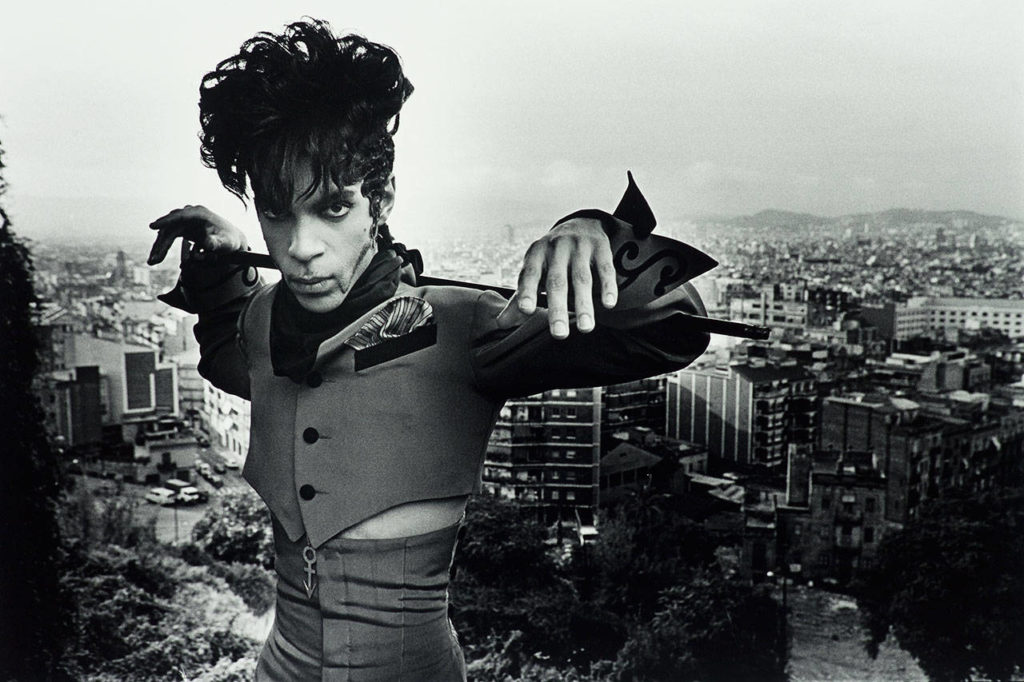At 27, I wasn’t around when Prince exploded on the scene with “Purple Rain” in 1984. But my mom disapproved of my generation’s music, so I grew up on 1980s tunes. That means, of course, Prince.
I recently visited “Prince From Minneapolis,” the Museum of Pop Culture’s exhibit on the musician’s image and impact on other artists. It includes a replica of the 1981 Hondamatic motorcycle Prince rides in “Purple Rain.” I couldn’t pass up the opportunity to sit astride the purple bike; fortunately, it’s bolted to the floor.
Neither could Steve Perovich of Seattle. He enthusiastically threw on a sequin jacket and hopped aboard the bike for a photo op. “I grew up in the era, so it’s fun for me,” he said.
Around the corner, Lew and Kris Morrison examined one of the outfits Prince wore in “Purple Rain.” The couple was vacationing in Seattle when they heard “Prince From Minneapolis” was at MoPOP. They just had to go — after all, they’re from the rock icon’s hometown.
“He’s a man of his decade,” said Lew Morrison, adding that he believes Prince was “a whole lot better than Michael Jackson.”
Born Prince Rogers Nelson on June 7, 1958, the musician, songwriter and producer grabbed the nation’s attention in the 1980s with his unique sound, which melded the rock, funk, soul and R&B genres, wide-ranging singing abilities, virtuoso musicianship and singularly charismatic stage presence.
“Purple Rain” was a major box-office hit and cemented Prince’s superstar status. His records have sold more than 100 million copies worldwide. He was inducted into the Rock and Roll Hall of Fame in 2004. His unexpected death, of an accidental drug overdose on April 21, 2016 at 57, shocked the music world. I was heartbroken.
In the exhibit, just past the tornado of guitars and nestled behind the tribute to Jimi Hendrix, from whom Prince drew inspiration, you’ll find 50 artifacts, 25 photographs, 15 Prince-inspired artworks, one of his distinctive guitars and two outfits from “Purple Rain.”
“He’s a person who worked hard and held true to his vision,” said Brooks Peck, MoPOP curator. “I’d love people to be reminded of that.”
Peck said the exhibit humanizes the rock icon. Photos from early in his career show a “shy” and sometimes “embarrassed” 19-year-old.
“At the start of Prince’s career, he worked, like so many aspiring musicians and artists, to create a unique and dynamic professional image,” reads one of the signs at the exhibit. “He reached out to photographers in his local community and several Twin Cities picture makers participated in the construction and dissemination of what is now his legendary image and identity.”
Most of the artifacts on exhibit are borrowed from The Weisman Art Museum in Minneapolis. But the Seattle offering adds some of its own touches. For example, MoPOP recreated the “Purple Rain” bike and obtained a Cloud guitar just like the uniquely shaped instrument Prince plays in the movie.
Peck said he was “tickled” to add items from the museum’s own collection, such as a cash register from the legendary First Avenue nightclub in Minneapolis, where Prince launched his career. First Avenue was featured prominently in “Purple Rain.”
Visitors will see “Love Symbol No. 2,” the purple Pantone color created for Prince; “Love Symbol” was the name of the graphic Prince took for his name, in protest against his record company, during the “artist formerly known as Prince” stage of his career.
The exhibit, though, is about more than Prince himself. It’s a testament to his influence on other artists. On display are glassworks, a mural and other art pieces influenced by Prince. These are the types of “creative exchanges” MoPOP likes to emphasize, Peck said.
One artwork that stood out to me is called “Prince Spirit Animal,” created by brothers Einar and Jamex de la Torre. It draws from Mexican folk art, pop culture and mythology. It’s a strange little creature with big bug eyes, large droopy ears and a thin mustache. It’s weird, but it really drew me in. It was so clearly inspired by Prince.
Seeing that glass art made me realize the impact Prince had on art, not just music. I really had no idea.
“Prince had all these other dimensions,” Peck said. “I just see him as this quintessential creator who knows exactly the vision he wants and is uncompromising to getting to that.”
As you stroll through the exhibit, some of Prince’s most popular songs, like “Kiss” or “Diamonds and Pearls,” play overhead. Music he collaborated on and covers from the “Purple Rain” soundtrack, like Incubus’ take on “Let’s Go Crazy,” are also mixed into the playlist. I sang along as I toured the exhibit.
You can take a seat and watch music video clips on a giant screen, interspersed with an interview that Kevin Cole, Prince’s personal DJ, did with KEXP-FM in Seattle.
“You don’t have to be a hardcore Prince fan to enjoy the exhibit,” Peck said.
I’m not a hardcore Prince fan, either, but he was part of the soundtrack of my childhood. And now, thanks to MoPOP’s exhibit, I understand just how significant his influence was.
If you go
“Prince From Minneapolis” is showing at the Museum of Pop Culture, formerly the EMP, 325 Fifth Ave. N., Seattle, through Jan. 4, 2020. Tickets are $23-$32 for non-members. More at www.mopop.org.
Talk to us
> Give us your news tips.
> Send us a letter to the editor.
> More Herald contact information.






























